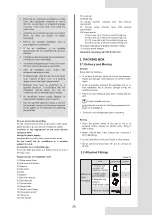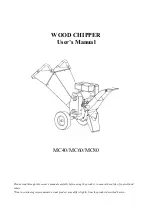
24
4.4 Fault Symptom: Non Air
Conditioning Issues
Symptom 1: The system does not operate
Symptom 2: The system switches into the fan mode
during cooling
Symptom 3: White mist comes out of a unit
Symptom 4: Noise of air conditioners cooling
The air conditioner does not start immediately after
the ON/OFF button on the remote controller is
pressed.
If the operation lamp lights up, the system is in
normal condition. To prevent overloading of the
compressor motor, the air conditioner starts 3
minutes after it is turned on.
If the operation lamp and the "PRE-DEF indicator
(cooling and heating type) or fan only indicator
(cooling only type)" light up, it means you must
choose the heating mode. When just starting, if the
compressor has not started, the indoor unit displays
"anti cold wind" protection because the air outlet
temperature is too low.
In order to prevent the indoor evaporator from
frosting, the system will switch into fan mode
automatically, and return to the cooling mode soon.
When the room temperature drops to the set
temperature, the compressor goes off and the
indoor unit switches to fan mode; when the
temperature increases, the compressor starts
again. It is same in heating mode.
Symptom 3.1: Indoor unit
Symptom 3.2: Indoor unit, outdoor unit
Symptom 4.1: Indoor unit
When humidity is high during cooling operation. If
the interior of an indoor unit is extremely
contaminated, the temperature distribution inside a
room becomes uneven. It is necessary to clean the
interior of the indoor unit. Ask your dealer for details
on cleaning the unit. This operation requires a
qualified service person
When the system switches over to heating operation
after defrost operation, moisture generated by
defrosting becomes steam and is exhausted.
A continuous low "shah" sound is heard when the
system is in cooling operation or stops.
When the drain pump (optional accessories) is in
operation, this noise is heard.
A "pishi-pishi" squeaking sound is heard when the
system stops after heating operation.
Expansion and contraction of plastic parts caused
by temperature changes can make this noise.
Symptom 4.2: Indoor unit, outdoor unit
A continuous low hissing sound is heard when the
system is in operation.
This is the sound of refrigerant gas flowing through
both indoor and outdoor units.
A hissing sound is heard at the start or immediately
after stopping operation or defrost operation.
This is the noise of refrigerant caused by flow stops
or flow changes.
Symptom 4.3: Outdoor unit
When the tone of operating noise changes, the
noise is caused by the change of frequency.
Symptom 5: Dust comes out of the unit
Symptom 6: The units give off odors
When the unit is used for the first time in a long
time, it is because dust has gotten into the unit.
The unit can absorb the smell of rooms, furniture,
cigarettes, etc., and then emit it again.
Symptom 7: The outdoor unit fan does not spin.
During operation, the speed of the fan is controlled
in order to optimize product operation.
5 CHANGING INSTALLATION SITE
Please contact the agent to dismantle and reinstall all
the units. You need specialized skills and technology to
move the units.
6 DISPOSAL
This unit uses hydrogen fluorocarbons. Please contact
the agent when you want to dispose of this unit. Based
on the requirements of the law, the collection,
transportation and disposal of refrigerants must conform
with the regulations governing the collection and
destruction of hydrofluorocarbons.
















































